Management Accounting Systems and Techniques for Oshodi Plc
VerifiedAdded on 2021/02/20
|17
|5461
|17
Report
AI Summary
This report provides a detailed analysis of management accounting systems and their application within Oshodi Plc, a manufacturing company specializing in JOJO fruit juice. The report covers various aspects of management accounting, including the essential requirements of management accounting systems, the benefits of these systems, and the integration of management accounting within organizational processes. It explores different methods of management accounting reports, such as budgeting reports, accounts receivable aging reports, inventory and manufacturing reports, and performance reports. Furthermore, the report delves into cost analysis techniques, specifically marginal and absorption costing, and their role in preparing income statements. It also examines the advantages of various planning tools used for budgetary control and their application in preparing and forecasting budgets. Finally, the report addresses the adoption of management accounting systems to respond to financial problems and the contribution of management accounting in ensuring the sustainable success of the organization.
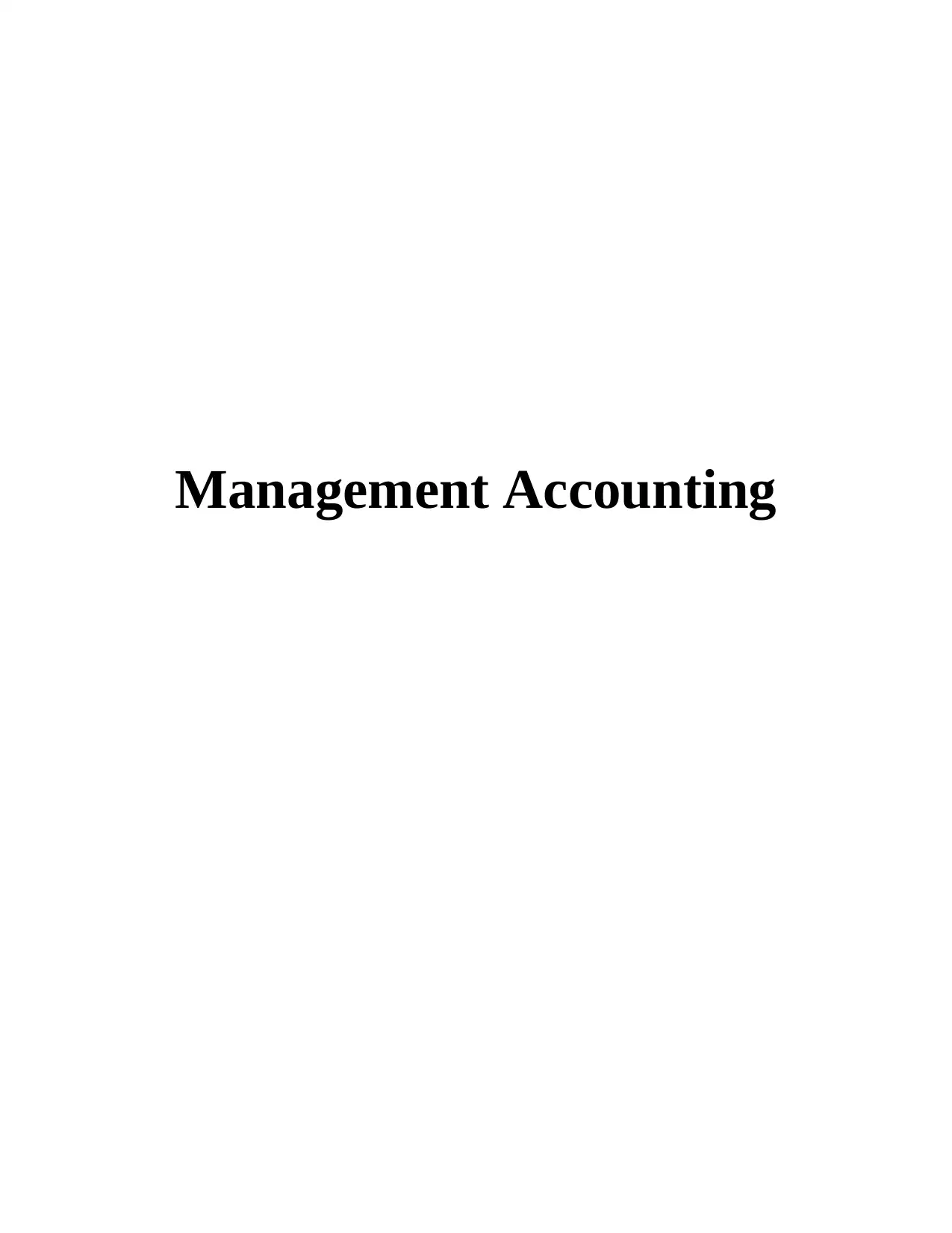
Management Accounting
Paraphrase This Document
Need a fresh take? Get an instant paraphrase of this document with our AI Paraphraser
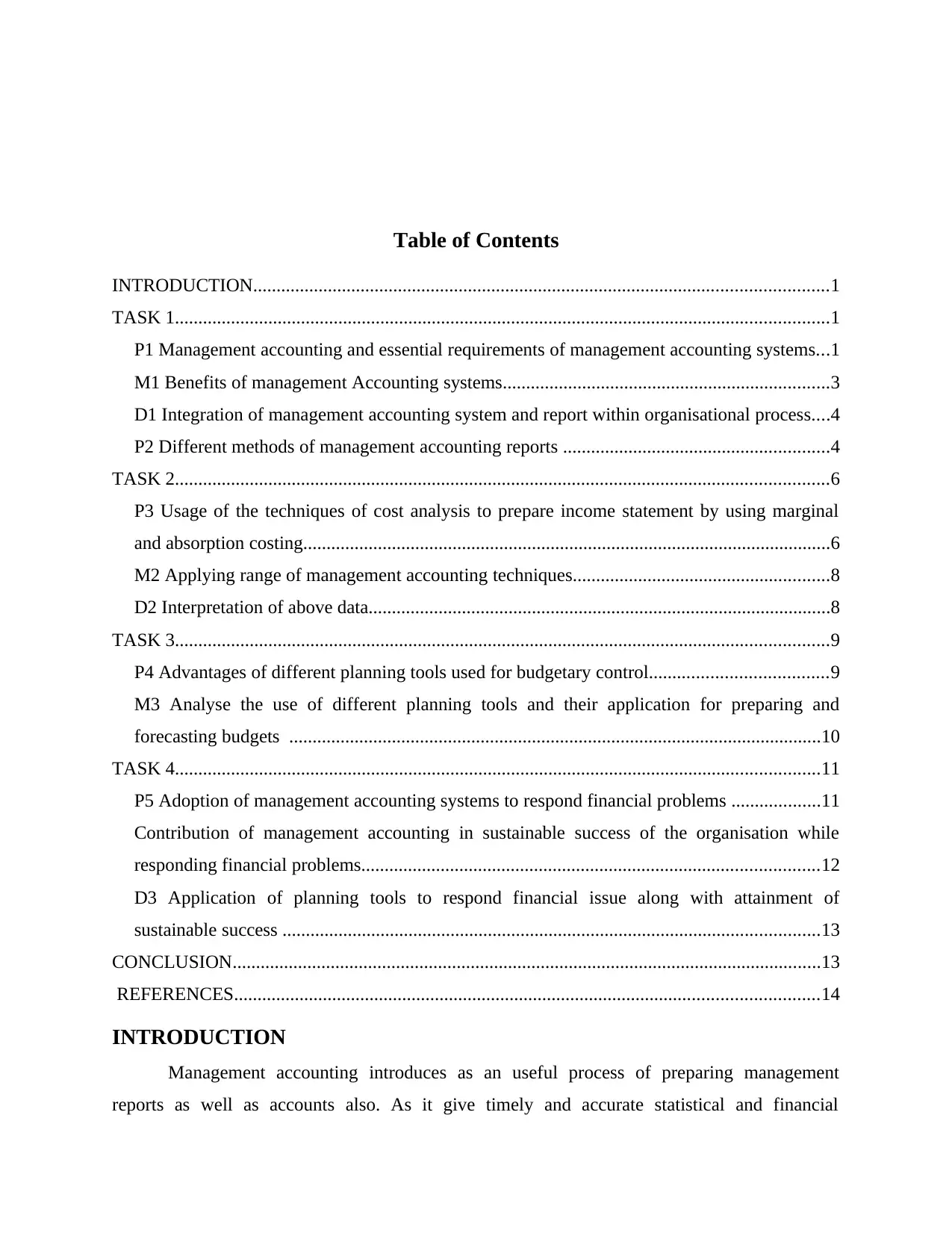
Table of Contents
INTRODUCTION...........................................................................................................................1
TASK 1............................................................................................................................................1
P1 Management accounting and essential requirements of management accounting systems...1
M1 Benefits of management Accounting systems......................................................................3
D1 Integration of management accounting system and report within organisational process....4
P2 Different methods of management accounting reports .........................................................4
TASK 2............................................................................................................................................6
P3 Usage of the techniques of cost analysis to prepare income statement by using marginal
and absorption costing.................................................................................................................6
M2 Applying range of management accounting techniques.......................................................8
D2 Interpretation of above data...................................................................................................8
TASK 3............................................................................................................................................9
P4 Advantages of different planning tools used for budgetary control......................................9
M3 Analyse the use of different planning tools and their application for preparing and
forecasting budgets ..................................................................................................................10
TASK 4..........................................................................................................................................11
P5 Adoption of management accounting systems to respond financial problems ...................11
Contribution of management accounting in sustainable success of the organisation while
responding financial problems..................................................................................................12
D3 Application of planning tools to respond financial issue along with attainment of
sustainable success ...................................................................................................................13
CONCLUSION..............................................................................................................................13
REFERENCES.............................................................................................................................14
INTRODUCTION
Management accounting introduces as an useful process of preparing management
reports as well as accounts also. As it give timely and accurate statistical and financial
INTRODUCTION...........................................................................................................................1
TASK 1............................................................................................................................................1
P1 Management accounting and essential requirements of management accounting systems...1
M1 Benefits of management Accounting systems......................................................................3
D1 Integration of management accounting system and report within organisational process....4
P2 Different methods of management accounting reports .........................................................4
TASK 2............................................................................................................................................6
P3 Usage of the techniques of cost analysis to prepare income statement by using marginal
and absorption costing.................................................................................................................6
M2 Applying range of management accounting techniques.......................................................8
D2 Interpretation of above data...................................................................................................8
TASK 3............................................................................................................................................9
P4 Advantages of different planning tools used for budgetary control......................................9
M3 Analyse the use of different planning tools and their application for preparing and
forecasting budgets ..................................................................................................................10
TASK 4..........................................................................................................................................11
P5 Adoption of management accounting systems to respond financial problems ...................11
Contribution of management accounting in sustainable success of the organisation while
responding financial problems..................................................................................................12
D3 Application of planning tools to respond financial issue along with attainment of
sustainable success ...................................................................................................................13
CONCLUSION..............................................................................................................................13
REFERENCES.............................................................................................................................14
INTRODUCTION
Management accounting introduces as an useful process of preparing management
reports as well as accounts also. As it give timely and accurate statistical and financial
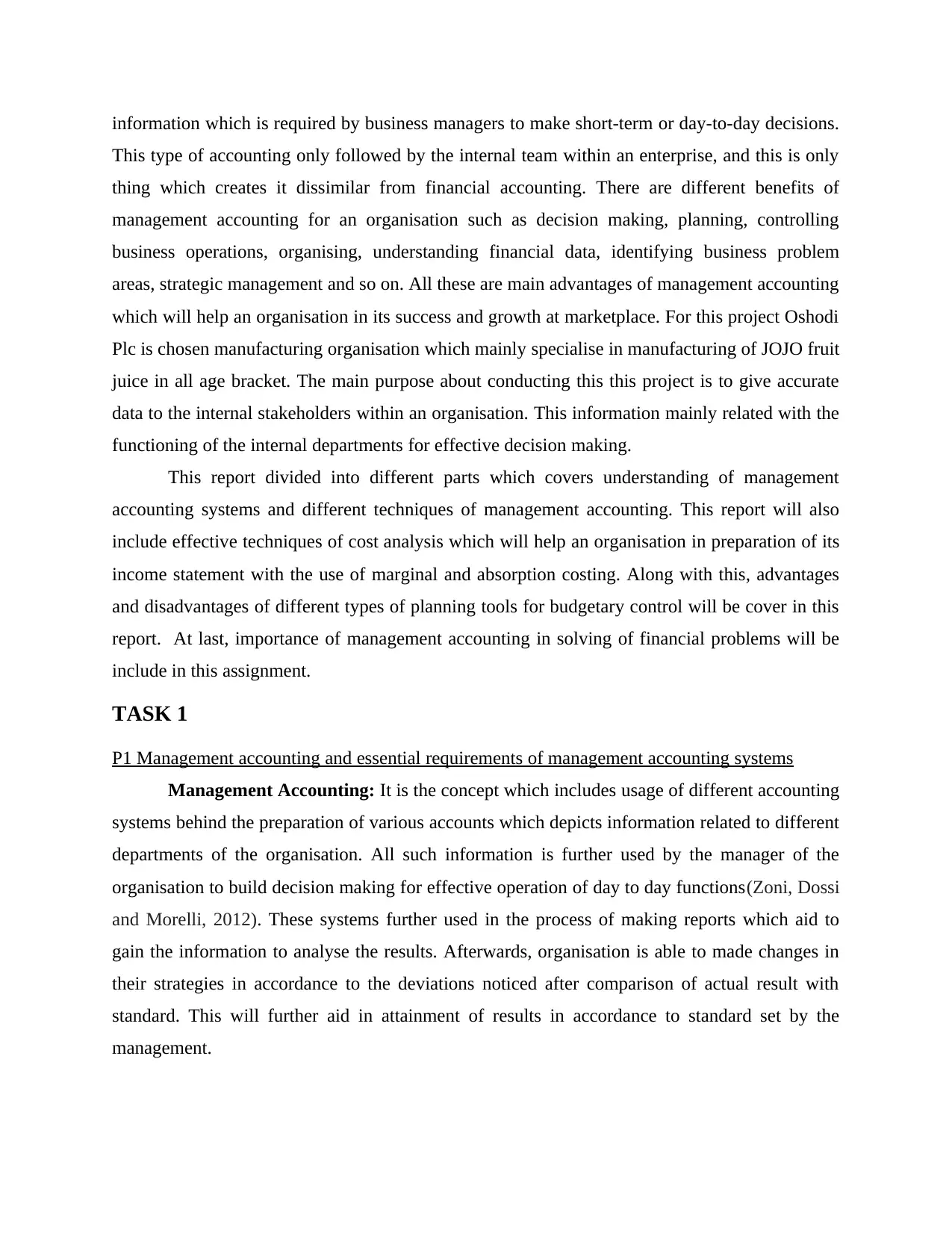
information which is required by business managers to make short-term or day-to-day decisions.
This type of accounting only followed by the internal team within an enterprise, and this is only
thing which creates it dissimilar from financial accounting. There are different benefits of
management accounting for an organisation such as decision making, planning, controlling
business operations, organising, understanding financial data, identifying business problem
areas, strategic management and so on. All these are main advantages of management accounting
which will help an organisation in its success and growth at marketplace. For this project Oshodi
Plc is chosen manufacturing organisation which mainly specialise in manufacturing of JOJO fruit
juice in all age bracket. The main purpose about conducting this this project is to give accurate
data to the internal stakeholders within an organisation. This information mainly related with the
functioning of the internal departments for effective decision making.
This report divided into different parts which covers understanding of management
accounting systems and different techniques of management accounting. This report will also
include effective techniques of cost analysis which will help an organisation in preparation of its
income statement with the use of marginal and absorption costing. Along with this, advantages
and disadvantages of different types of planning tools for budgetary control will be cover in this
report. At last, importance of management accounting in solving of financial problems will be
include in this assignment.
TASK 1
P1 Management accounting and essential requirements of management accounting systems
Management Accounting: It is the concept which includes usage of different accounting
systems behind the preparation of various accounts which depicts information related to different
departments of the organisation. All such information is further used by the manager of the
organisation to build decision making for effective operation of day to day functions(Zoni, Dossi
and Morelli, 2012). These systems further used in the process of making reports which aid to
gain the information to analyse the results. Afterwards, organisation is able to made changes in
their strategies in accordance to the deviations noticed after comparison of actual result with
standard. This will further aid in attainment of results in accordance to standard set by the
management.
This type of accounting only followed by the internal team within an enterprise, and this is only
thing which creates it dissimilar from financial accounting. There are different benefits of
management accounting for an organisation such as decision making, planning, controlling
business operations, organising, understanding financial data, identifying business problem
areas, strategic management and so on. All these are main advantages of management accounting
which will help an organisation in its success and growth at marketplace. For this project Oshodi
Plc is chosen manufacturing organisation which mainly specialise in manufacturing of JOJO fruit
juice in all age bracket. The main purpose about conducting this this project is to give accurate
data to the internal stakeholders within an organisation. This information mainly related with the
functioning of the internal departments for effective decision making.
This report divided into different parts which covers understanding of management
accounting systems and different techniques of management accounting. This report will also
include effective techniques of cost analysis which will help an organisation in preparation of its
income statement with the use of marginal and absorption costing. Along with this, advantages
and disadvantages of different types of planning tools for budgetary control will be cover in this
report. At last, importance of management accounting in solving of financial problems will be
include in this assignment.
TASK 1
P1 Management accounting and essential requirements of management accounting systems
Management Accounting: It is the concept which includes usage of different accounting
systems behind the preparation of various accounts which depicts information related to different
departments of the organisation. All such information is further used by the manager of the
organisation to build decision making for effective operation of day to day functions(Zoni, Dossi
and Morelli, 2012). These systems further used in the process of making reports which aid to
gain the information to analyse the results. Afterwards, organisation is able to made changes in
their strategies in accordance to the deviations noticed after comparison of actual result with
standard. This will further aid in attainment of results in accordance to standard set by the
management.
⊘ This is a preview!⊘
Do you want full access?
Subscribe today to unlock all pages.

Trusted by 1+ million students worldwide

Management Accounting system: These systems are different type of accounts prepared
by the accountant to grab the information about the strength of internal departments working and
their contribution behind accomplishment of desired results. The different type of systems which
are prepared by Oshodi includes cost accounting, job costing. Inventory management and price
optimisation system. All these systems are different in nature and having their own contribution
within the organisation. Through proper study of all the information, manager able to get insight
into the departmental functioning(Bryer, 2013). The functioning of different accounting system
has their own contribution in the development of the organisation and accomplishment of the
objectives that can be ascertained from the description presented below:
Cost accounting system: This system is used for the purpose of analysing total cost of
the product. The same system is used by Oshodi to analyse the cost they incurred in the process
of preparing JOJO fruit juice. The main advantage that can gathered by the organisation with the
help of this method is about ascertainment of the financial performance by input results with the
actual. Also, this will help the management is ascertaining the contribution made by the JOJO
fruit juice in process of creating profit.
Inventory management system: The main function of this system is about effective
management of stock within the organisation by tracking the level of inventories they have at
warehouse. For the same purpose, Oshodi use this system and further use the results in creation
of work order, bill of materials in respect of the inventories which are used in preparation of
JOJO fruit juice. It improves the inventory management of the organisation and allows to track
the whole supply chain which is used to handle the whole process from production to retail.
Another benefit which is associated with this is about maintaining the inventory and focus on
continuous production of JOJO fruit juice without any disruption. The methods that can be used
very frequently in management of inventory are named as LIFO, FIFO and AVCO. To manage
the inventories in warehouse the method which is used is FIFO. For the purpose of ascertaining
the time period for re order of the raw material EOQ method is used(Grabner and Moers, 2013).
This will help to grab the information about the time period under which organisation has re
order their inventories.
Price optimisation system: The main function of this system is about ascertain the
behaviour of consumers on the different price of the fruit juice. The main advantage is that it
by the accountant to grab the information about the strength of internal departments working and
their contribution behind accomplishment of desired results. The different type of systems which
are prepared by Oshodi includes cost accounting, job costing. Inventory management and price
optimisation system. All these systems are different in nature and having their own contribution
within the organisation. Through proper study of all the information, manager able to get insight
into the departmental functioning(Bryer, 2013). The functioning of different accounting system
has their own contribution in the development of the organisation and accomplishment of the
objectives that can be ascertained from the description presented below:
Cost accounting system: This system is used for the purpose of analysing total cost of
the product. The same system is used by Oshodi to analyse the cost they incurred in the process
of preparing JOJO fruit juice. The main advantage that can gathered by the organisation with the
help of this method is about ascertainment of the financial performance by input results with the
actual. Also, this will help the management is ascertaining the contribution made by the JOJO
fruit juice in process of creating profit.
Inventory management system: The main function of this system is about effective
management of stock within the organisation by tracking the level of inventories they have at
warehouse. For the same purpose, Oshodi use this system and further use the results in creation
of work order, bill of materials in respect of the inventories which are used in preparation of
JOJO fruit juice. It improves the inventory management of the organisation and allows to track
the whole supply chain which is used to handle the whole process from production to retail.
Another benefit which is associated with this is about maintaining the inventory and focus on
continuous production of JOJO fruit juice without any disruption. The methods that can be used
very frequently in management of inventory are named as LIFO, FIFO and AVCO. To manage
the inventories in warehouse the method which is used is FIFO. For the purpose of ascertaining
the time period for re order of the raw material EOQ method is used(Grabner and Moers, 2013).
This will help to grab the information about the time period under which organisation has re
order their inventories.
Price optimisation system: The main function of this system is about ascertain the
behaviour of consumers on the different price of the fruit juice. The main advantage is that it
Paraphrase This Document
Need a fresh take? Get an instant paraphrase of this document with our AI Paraphraser
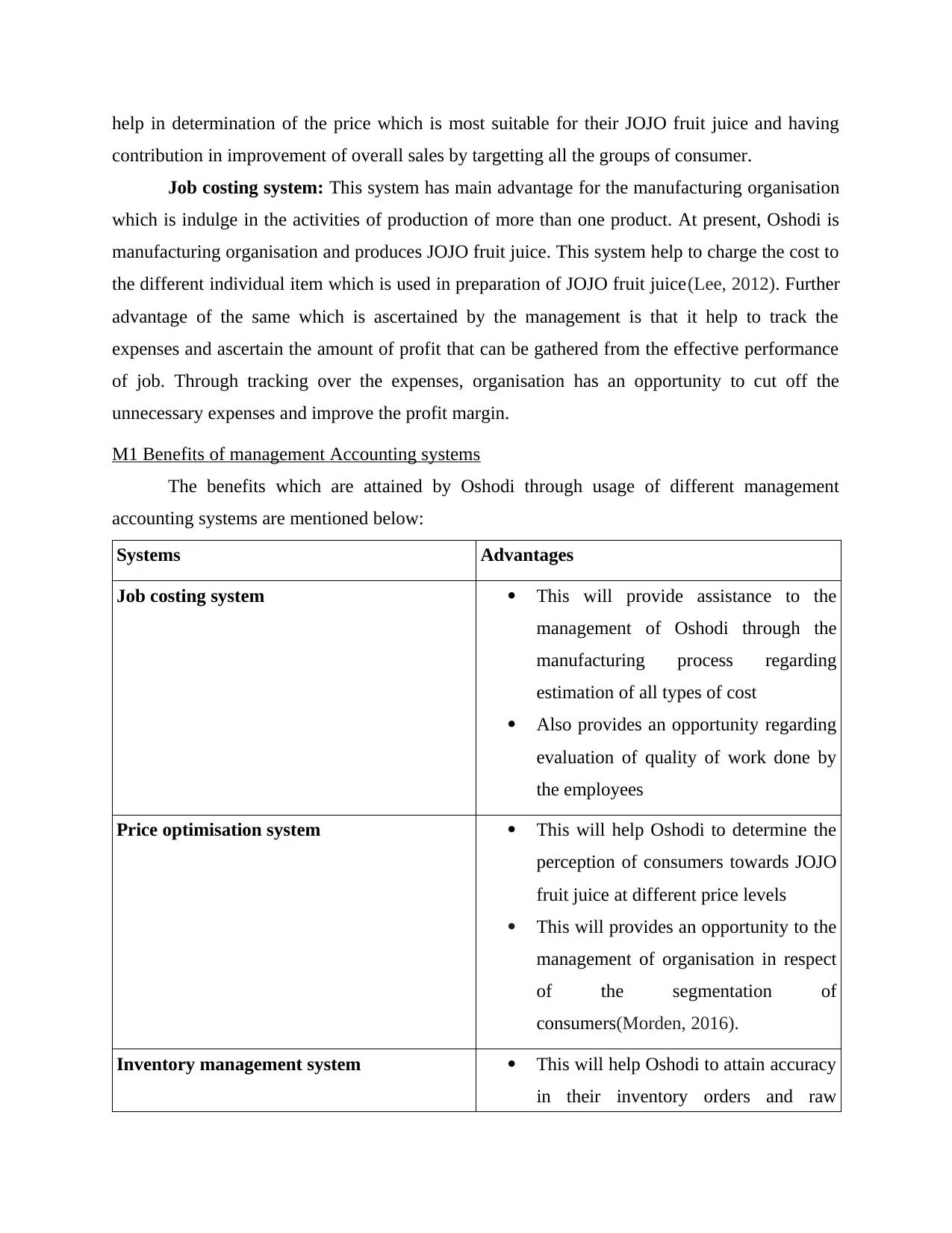
help in determination of the price which is most suitable for their JOJO fruit juice and having
contribution in improvement of overall sales by targetting all the groups of consumer.
Job costing system: This system has main advantage for the manufacturing organisation
which is indulge in the activities of production of more than one product. At present, Oshodi is
manufacturing organisation and produces JOJO fruit juice. This system help to charge the cost to
the different individual item which is used in preparation of JOJO fruit juice(Lee, 2012). Further
advantage of the same which is ascertained by the management is that it help to track the
expenses and ascertain the amount of profit that can be gathered from the effective performance
of job. Through tracking over the expenses, organisation has an opportunity to cut off the
unnecessary expenses and improve the profit margin.
M1 Benefits of management Accounting systems
The benefits which are attained by Oshodi through usage of different management
accounting systems are mentioned below:
Systems Advantages
Job costing system This will provide assistance to the
management of Oshodi through the
manufacturing process regarding
estimation of all types of cost
Also provides an opportunity regarding
evaluation of quality of work done by
the employees
Price optimisation system This will help Oshodi to determine the
perception of consumers towards JOJO
fruit juice at different price levels
This will provides an opportunity to the
management of organisation in respect
of the segmentation of
consumers(Morden, 2016).
Inventory management system This will help Oshodi to attain accuracy
in their inventory orders and raw
contribution in improvement of overall sales by targetting all the groups of consumer.
Job costing system: This system has main advantage for the manufacturing organisation
which is indulge in the activities of production of more than one product. At present, Oshodi is
manufacturing organisation and produces JOJO fruit juice. This system help to charge the cost to
the different individual item which is used in preparation of JOJO fruit juice(Lee, 2012). Further
advantage of the same which is ascertained by the management is that it help to track the
expenses and ascertain the amount of profit that can be gathered from the effective performance
of job. Through tracking over the expenses, organisation has an opportunity to cut off the
unnecessary expenses and improve the profit margin.
M1 Benefits of management Accounting systems
The benefits which are attained by Oshodi through usage of different management
accounting systems are mentioned below:
Systems Advantages
Job costing system This will provide assistance to the
management of Oshodi through the
manufacturing process regarding
estimation of all types of cost
Also provides an opportunity regarding
evaluation of quality of work done by
the employees
Price optimisation system This will help Oshodi to determine the
perception of consumers towards JOJO
fruit juice at different price levels
This will provides an opportunity to the
management of organisation in respect
of the segmentation of
consumers(Morden, 2016).
Inventory management system This will help Oshodi to attain accuracy
in their inventory orders and raw
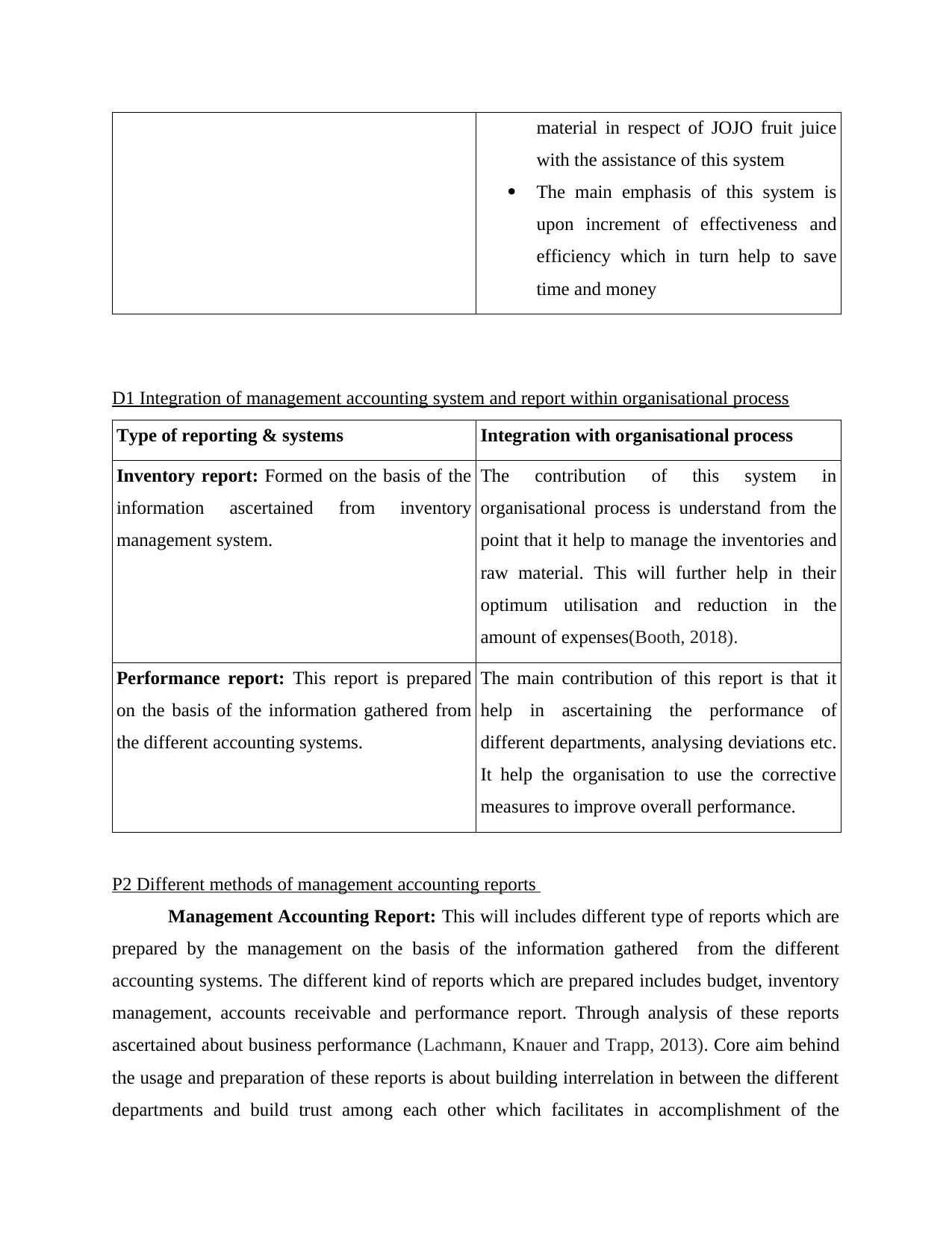
material in respect of JOJO fruit juice
with the assistance of this system
The main emphasis of this system is
upon increment of effectiveness and
efficiency which in turn help to save
time and money
D1 Integration of management accounting system and report within organisational process
Type of reporting & systems Integration with organisational process
Inventory report: Formed on the basis of the
information ascertained from inventory
management system.
The contribution of this system in
organisational process is understand from the
point that it help to manage the inventories and
raw material. This will further help in their
optimum utilisation and reduction in the
amount of expenses(Booth, 2018).
Performance report: This report is prepared
on the basis of the information gathered from
the different accounting systems.
The main contribution of this report is that it
help in ascertaining the performance of
different departments, analysing deviations etc.
It help the organisation to use the corrective
measures to improve overall performance.
P2 Different methods of management accounting reports
Management Accounting Report: This will includes different type of reports which are
prepared by the management on the basis of the information gathered from the different
accounting systems. The different kind of reports which are prepared includes budget, inventory
management, accounts receivable and performance report. Through analysis of these reports
ascertained about business performance (Lachmann, Knauer and Trapp, 2013). Core aim behind
the usage and preparation of these reports is about building interrelation in between the different
departments and build trust among each other which facilitates in accomplishment of the
with the assistance of this system
The main emphasis of this system is
upon increment of effectiveness and
efficiency which in turn help to save
time and money
D1 Integration of management accounting system and report within organisational process
Type of reporting & systems Integration with organisational process
Inventory report: Formed on the basis of the
information ascertained from inventory
management system.
The contribution of this system in
organisational process is understand from the
point that it help to manage the inventories and
raw material. This will further help in their
optimum utilisation and reduction in the
amount of expenses(Booth, 2018).
Performance report: This report is prepared
on the basis of the information gathered from
the different accounting systems.
The main contribution of this report is that it
help in ascertaining the performance of
different departments, analysing deviations etc.
It help the organisation to use the corrective
measures to improve overall performance.
P2 Different methods of management accounting reports
Management Accounting Report: This will includes different type of reports which are
prepared by the management on the basis of the information gathered from the different
accounting systems. The different kind of reports which are prepared includes budget, inventory
management, accounts receivable and performance report. Through analysis of these reports
ascertained about business performance (Lachmann, Knauer and Trapp, 2013). Core aim behind
the usage and preparation of these reports is about building interrelation in between the different
departments and build trust among each other which facilitates in accomplishment of the
⊘ This is a preview!⊘
Do you want full access?
Subscribe today to unlock all pages.

Trusted by 1+ million students worldwide
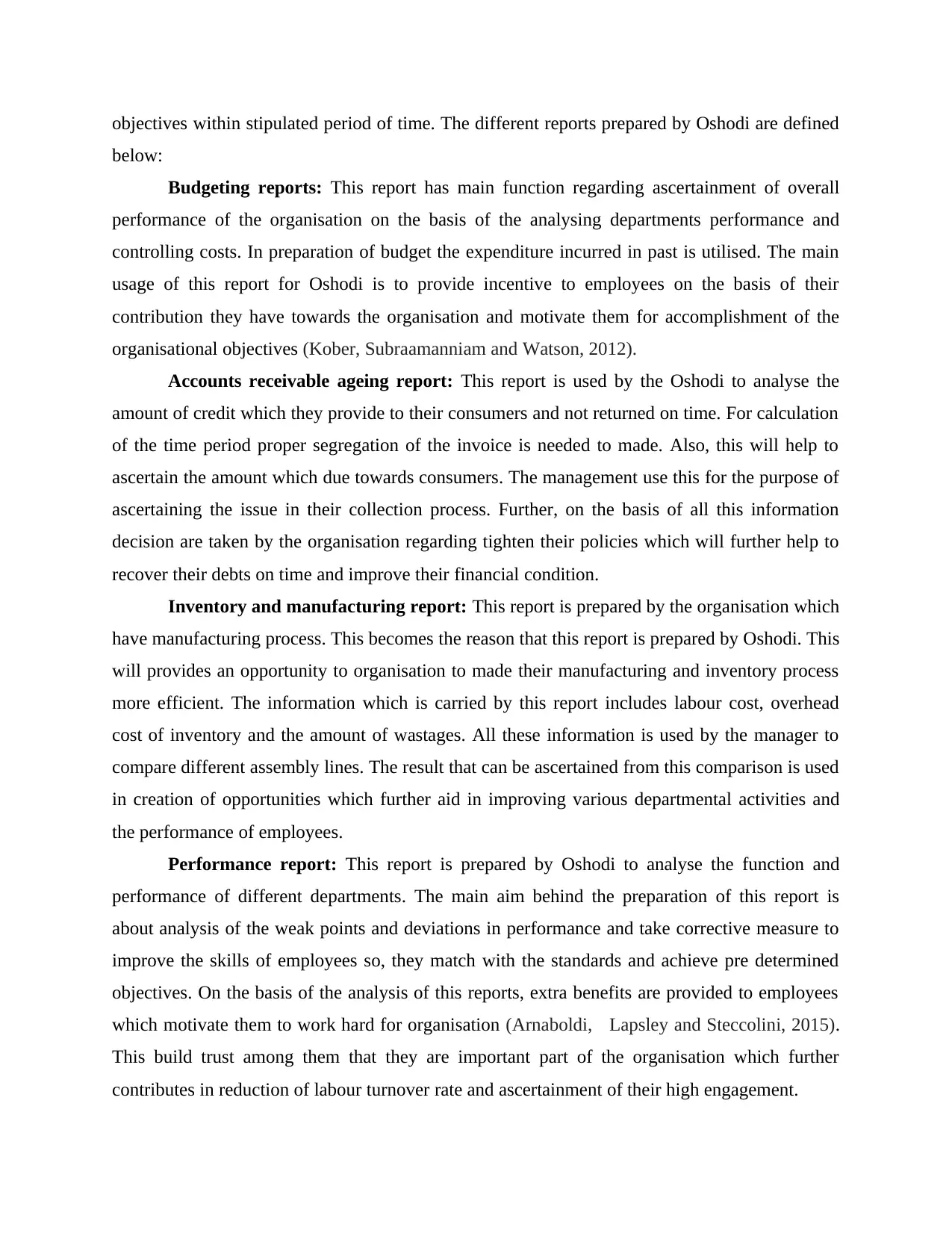
objectives within stipulated period of time. The different reports prepared by Oshodi are defined
below:
Budgeting reports: This report has main function regarding ascertainment of overall
performance of the organisation on the basis of the analysing departments performance and
controlling costs. In preparation of budget the expenditure incurred in past is utilised. The main
usage of this report for Oshodi is to provide incentive to employees on the basis of their
contribution they have towards the organisation and motivate them for accomplishment of the
organisational objectives (Kober, Subraamanniam and Watson, 2012).
Accounts receivable ageing report: This report is used by the Oshodi to analyse the
amount of credit which they provide to their consumers and not returned on time. For calculation
of the time period proper segregation of the invoice is needed to made. Also, this will help to
ascertain the amount which due towards consumers. The management use this for the purpose of
ascertaining the issue in their collection process. Further, on the basis of all this information
decision are taken by the organisation regarding tighten their policies which will further help to
recover their debts on time and improve their financial condition.
Inventory and manufacturing report: This report is prepared by the organisation which
have manufacturing process. This becomes the reason that this report is prepared by Oshodi. This
will provides an opportunity to organisation to made their manufacturing and inventory process
more efficient. The information which is carried by this report includes labour cost, overhead
cost of inventory and the amount of wastages. All these information is used by the manager to
compare different assembly lines. The result that can be ascertained from this comparison is used
in creation of opportunities which further aid in improving various departmental activities and
the performance of employees.
Performance report: This report is prepared by Oshodi to analyse the function and
performance of different departments. The main aim behind the preparation of this report is
about analysis of the weak points and deviations in performance and take corrective measure to
improve the skills of employees so, they match with the standards and achieve pre determined
objectives. On the basis of the analysis of this reports, extra benefits are provided to employees
which motivate them to work hard for organisation (Arnaboldi, Lapsley and Steccolini, 2015).
This build trust among them that they are important part of the organisation which further
contributes in reduction of labour turnover rate and ascertainment of their high engagement.
below:
Budgeting reports: This report has main function regarding ascertainment of overall
performance of the organisation on the basis of the analysing departments performance and
controlling costs. In preparation of budget the expenditure incurred in past is utilised. The main
usage of this report for Oshodi is to provide incentive to employees on the basis of their
contribution they have towards the organisation and motivate them for accomplishment of the
organisational objectives (Kober, Subraamanniam and Watson, 2012).
Accounts receivable ageing report: This report is used by the Oshodi to analyse the
amount of credit which they provide to their consumers and not returned on time. For calculation
of the time period proper segregation of the invoice is needed to made. Also, this will help to
ascertain the amount which due towards consumers. The management use this for the purpose of
ascertaining the issue in their collection process. Further, on the basis of all this information
decision are taken by the organisation regarding tighten their policies which will further help to
recover their debts on time and improve their financial condition.
Inventory and manufacturing report: This report is prepared by the organisation which
have manufacturing process. This becomes the reason that this report is prepared by Oshodi. This
will provides an opportunity to organisation to made their manufacturing and inventory process
more efficient. The information which is carried by this report includes labour cost, overhead
cost of inventory and the amount of wastages. All these information is used by the manager to
compare different assembly lines. The result that can be ascertained from this comparison is used
in creation of opportunities which further aid in improving various departmental activities and
the performance of employees.
Performance report: This report is prepared by Oshodi to analyse the function and
performance of different departments. The main aim behind the preparation of this report is
about analysis of the weak points and deviations in performance and take corrective measure to
improve the skills of employees so, they match with the standards and achieve pre determined
objectives. On the basis of the analysis of this reports, extra benefits are provided to employees
which motivate them to work hard for organisation (Arnaboldi, Lapsley and Steccolini, 2015).
This build trust among them that they are important part of the organisation which further
contributes in reduction of labour turnover rate and ascertainment of their high engagement.
Paraphrase This Document
Need a fresh take? Get an instant paraphrase of this document with our AI Paraphraser
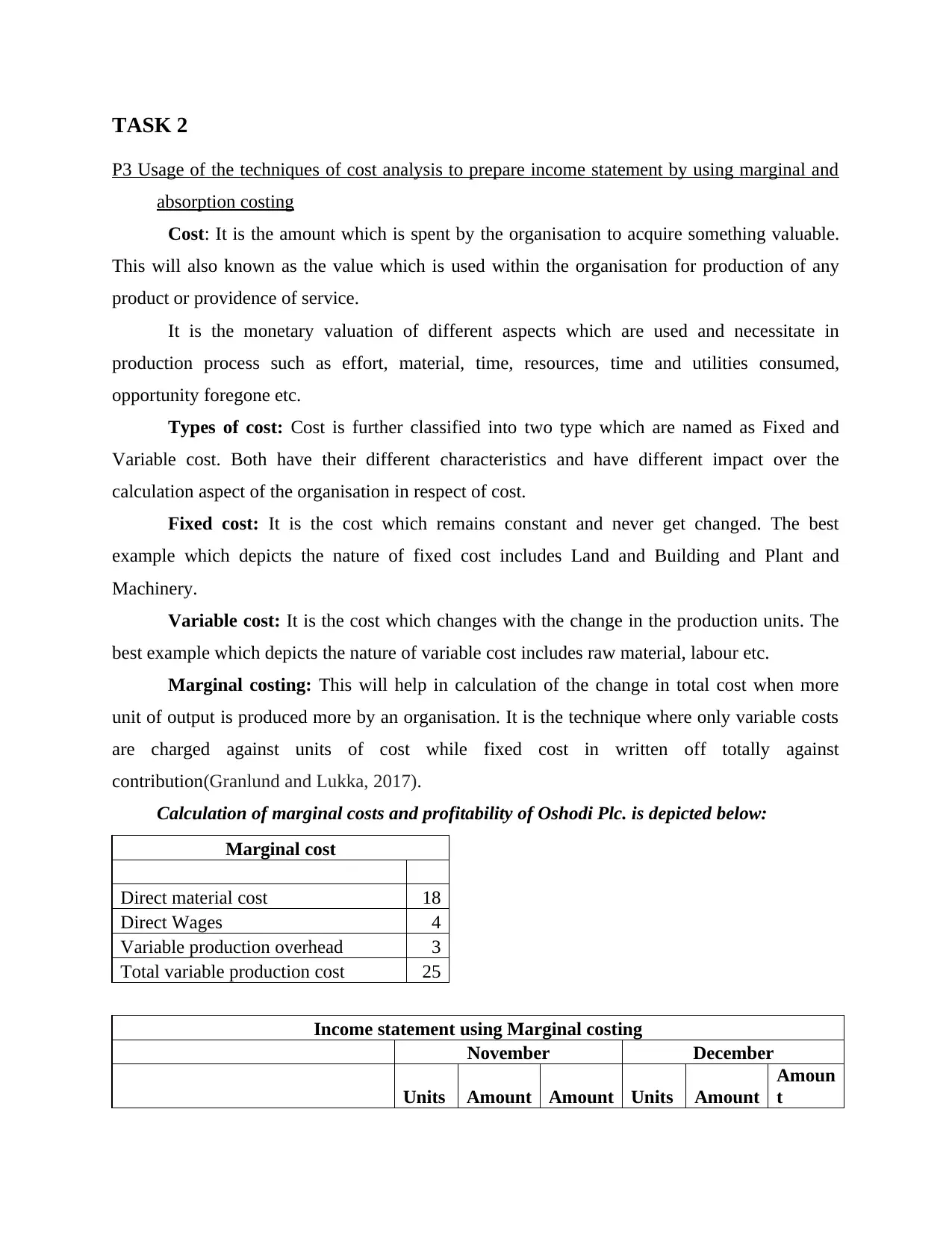
TASK 2
P3 Usage of the techniques of cost analysis to prepare income statement by using marginal and
absorption costing
Cost: It is the amount which is spent by the organisation to acquire something valuable.
This will also known as the value which is used within the organisation for production of any
product or providence of service.
It is the monetary valuation of different aspects which are used and necessitate in
production process such as effort, material, time, resources, time and utilities consumed,
opportunity foregone etc.
Types of cost: Cost is further classified into two type which are named as Fixed and
Variable cost. Both have their different characteristics and have different impact over the
calculation aspect of the organisation in respect of cost.
Fixed cost: It is the cost which remains constant and never get changed. The best
example which depicts the nature of fixed cost includes Land and Building and Plant and
Machinery.
Variable cost: It is the cost which changes with the change in the production units. The
best example which depicts the nature of variable cost includes raw material, labour etc.
Marginal costing: This will help in calculation of the change in total cost when more
unit of output is produced more by an organisation. It is the technique where only variable costs
are charged against units of cost while fixed cost in written off totally against
contribution(Granlund and Lukka, 2017).
Calculation of marginal costs and profitability of Oshodi Plc. is depicted below:
Marginal cost
Direct material cost 18
Direct Wages 4
Variable production overhead 3
Total variable production cost 25
Income statement using Marginal costing
November December
Units Amount Amount Units Amount
Amoun
t
P3 Usage of the techniques of cost analysis to prepare income statement by using marginal and
absorption costing
Cost: It is the amount which is spent by the organisation to acquire something valuable.
This will also known as the value which is used within the organisation for production of any
product or providence of service.
It is the monetary valuation of different aspects which are used and necessitate in
production process such as effort, material, time, resources, time and utilities consumed,
opportunity foregone etc.
Types of cost: Cost is further classified into two type which are named as Fixed and
Variable cost. Both have their different characteristics and have different impact over the
calculation aspect of the organisation in respect of cost.
Fixed cost: It is the cost which remains constant and never get changed. The best
example which depicts the nature of fixed cost includes Land and Building and Plant and
Machinery.
Variable cost: It is the cost which changes with the change in the production units. The
best example which depicts the nature of variable cost includes raw material, labour etc.
Marginal costing: This will help in calculation of the change in total cost when more
unit of output is produced more by an organisation. It is the technique where only variable costs
are charged against units of cost while fixed cost in written off totally against
contribution(Granlund and Lukka, 2017).
Calculation of marginal costs and profitability of Oshodi Plc. is depicted below:
Marginal cost
Direct material cost 18
Direct Wages 4
Variable production overhead 3
Total variable production cost 25
Income statement using Marginal costing
November December
Units Amount Amount Units Amount
Amoun
t
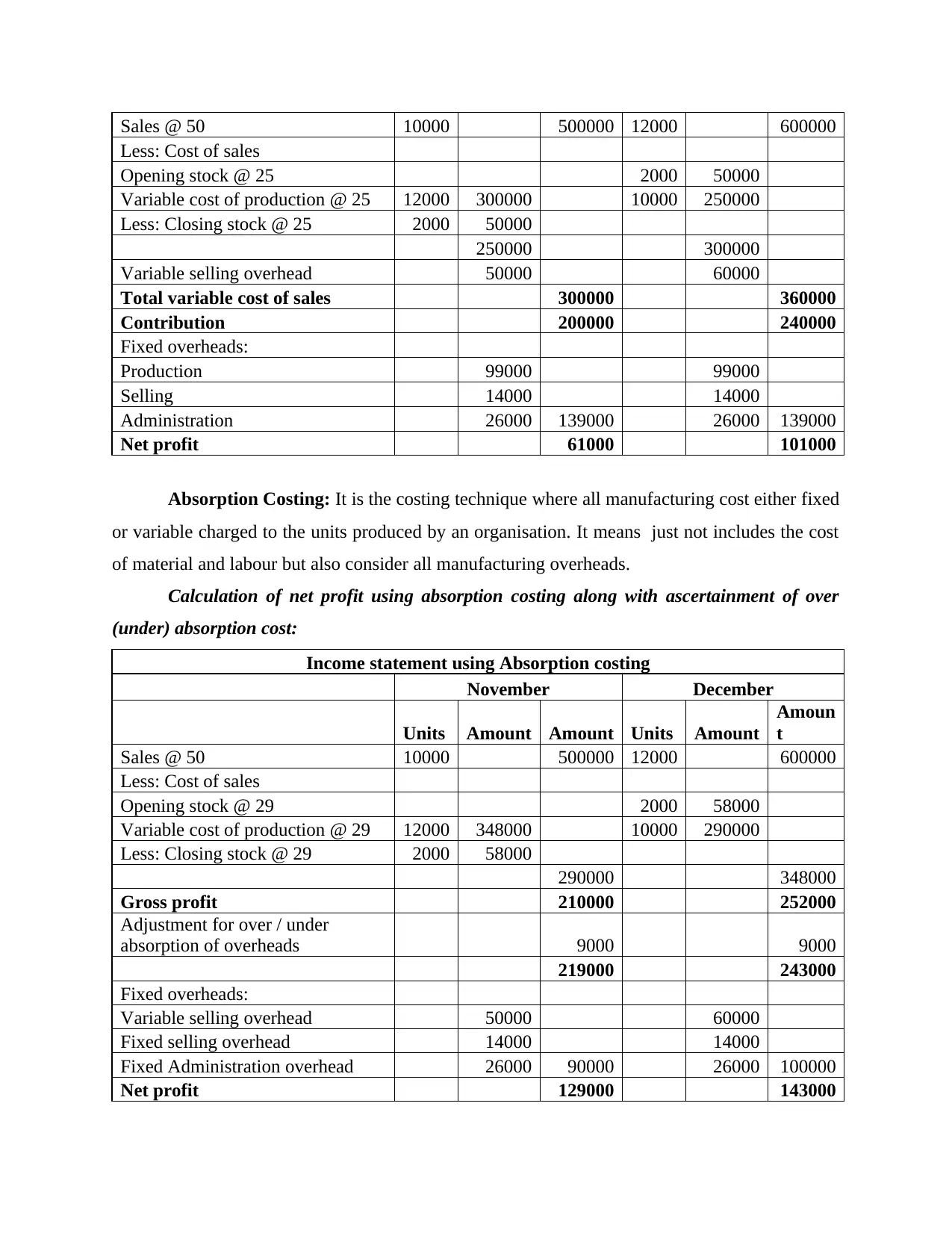
Sales @ 50 10000 500000 12000 600000
Less: Cost of sales
Opening stock @ 25 2000 50000
Variable cost of production @ 25 12000 300000 10000 250000
Less: Closing stock @ 25 2000 50000
250000 300000
Variable selling overhead 50000 60000
Total variable cost of sales 300000 360000
Contribution 200000 240000
Fixed overheads:
Production 99000 99000
Selling 14000 14000
Administration 26000 139000 26000 139000
Net profit 61000 101000
Absorption Costing: It is the costing technique where all manufacturing cost either fixed
or variable charged to the units produced by an organisation. It means just not includes the cost
of material and labour but also consider all manufacturing overheads.
Calculation of net profit using absorption costing along with ascertainment of over
(under) absorption cost:
Income statement using Absorption costing
November December
Units Amount Amount Units Amount
Amoun
t
Sales @ 50 10000 500000 12000 600000
Less: Cost of sales
Opening stock @ 29 2000 58000
Variable cost of production @ 29 12000 348000 10000 290000
Less: Closing stock @ 29 2000 58000
290000 348000
Gross profit 210000 252000
Adjustment for over / under
absorption of overheads 9000 9000
219000 243000
Fixed overheads:
Variable selling overhead 50000 60000
Fixed selling overhead 14000 14000
Fixed Administration overhead 26000 90000 26000 100000
Net profit 129000 143000
Less: Cost of sales
Opening stock @ 25 2000 50000
Variable cost of production @ 25 12000 300000 10000 250000
Less: Closing stock @ 25 2000 50000
250000 300000
Variable selling overhead 50000 60000
Total variable cost of sales 300000 360000
Contribution 200000 240000
Fixed overheads:
Production 99000 99000
Selling 14000 14000
Administration 26000 139000 26000 139000
Net profit 61000 101000
Absorption Costing: It is the costing technique where all manufacturing cost either fixed
or variable charged to the units produced by an organisation. It means just not includes the cost
of material and labour but also consider all manufacturing overheads.
Calculation of net profit using absorption costing along with ascertainment of over
(under) absorption cost:
Income statement using Absorption costing
November December
Units Amount Amount Units Amount
Amoun
t
Sales @ 50 10000 500000 12000 600000
Less: Cost of sales
Opening stock @ 29 2000 58000
Variable cost of production @ 29 12000 348000 10000 290000
Less: Closing stock @ 29 2000 58000
290000 348000
Gross profit 210000 252000
Adjustment for over / under
absorption of overheads 9000 9000
219000 243000
Fixed overheads:
Variable selling overhead 50000 60000
Fixed selling overhead 14000 14000
Fixed Administration overhead 26000 90000 26000 100000
Net profit 129000 143000
⊘ This is a preview!⊘
Do you want full access?
Subscribe today to unlock all pages.

Trusted by 1+ million students worldwide
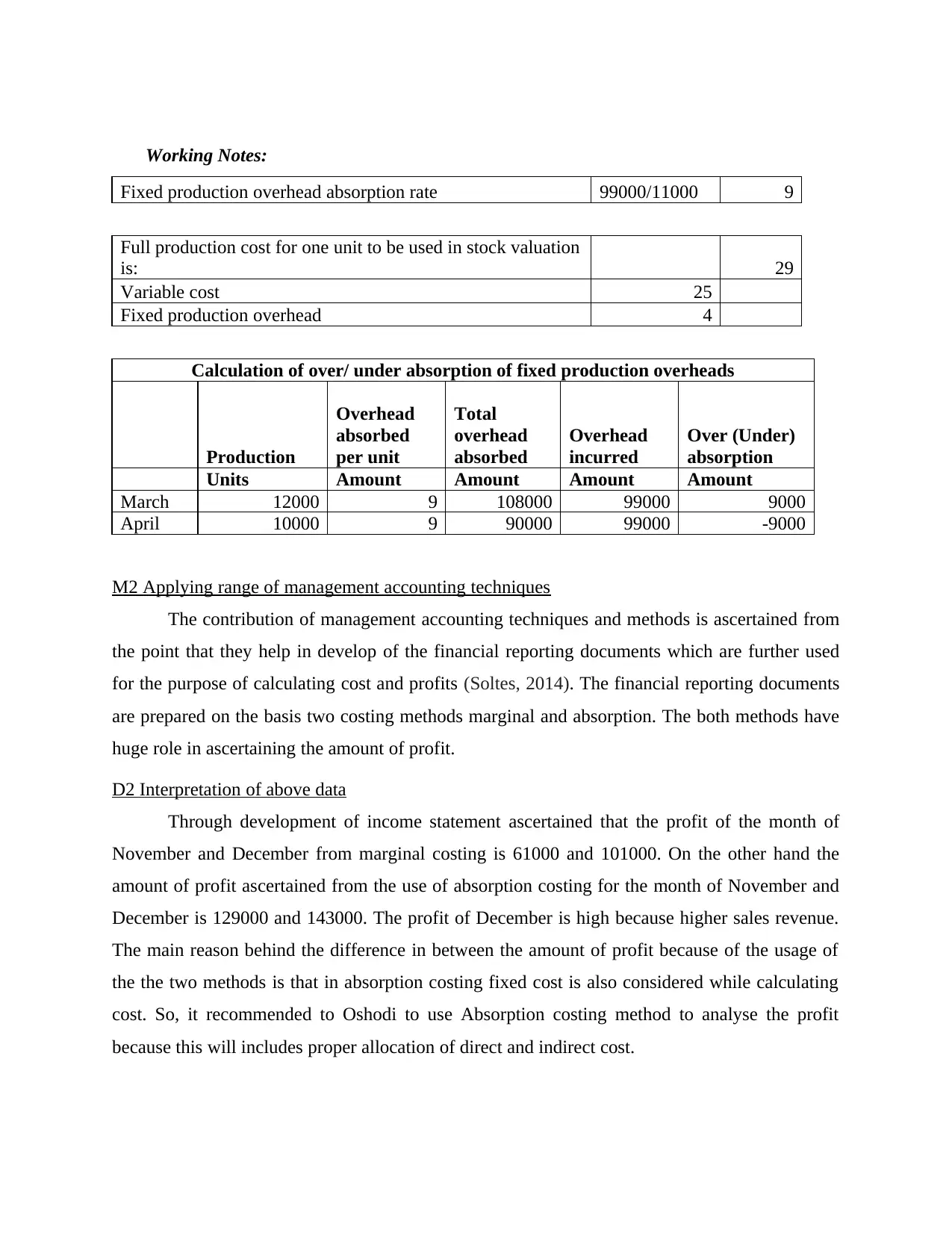
Working Notes:
Fixed production overhead absorption rate 99000/11000 9
Full production cost for one unit to be used in stock valuation
is: 29
Variable cost 25
Fixed production overhead 4
Calculation of over/ under absorption of fixed production overheads
Production
Overhead
absorbed
per unit
Total
overhead
absorbed
Overhead
incurred
Over (Under)
absorption
Units Amount Amount Amount Amount
March 12000 9 108000 99000 9000
April 10000 9 90000 99000 -9000
M2 Applying range of management accounting techniques
The contribution of management accounting techniques and methods is ascertained from
the point that they help in develop of the financial reporting documents which are further used
for the purpose of calculating cost and profits (Soltes, 2014). The financial reporting documents
are prepared on the basis two costing methods marginal and absorption. The both methods have
huge role in ascertaining the amount of profit.
D2 Interpretation of above data
Through development of income statement ascertained that the profit of the month of
November and December from marginal costing is 61000 and 101000. On the other hand the
amount of profit ascertained from the use of absorption costing for the month of November and
December is 129000 and 143000. The profit of December is high because higher sales revenue.
The main reason behind the difference in between the amount of profit because of the usage of
the the two methods is that in absorption costing fixed cost is also considered while calculating
cost. So, it recommended to Oshodi to use Absorption costing method to analyse the profit
because this will includes proper allocation of direct and indirect cost.
Fixed production overhead absorption rate 99000/11000 9
Full production cost for one unit to be used in stock valuation
is: 29
Variable cost 25
Fixed production overhead 4
Calculation of over/ under absorption of fixed production overheads
Production
Overhead
absorbed
per unit
Total
overhead
absorbed
Overhead
incurred
Over (Under)
absorption
Units Amount Amount Amount Amount
March 12000 9 108000 99000 9000
April 10000 9 90000 99000 -9000
M2 Applying range of management accounting techniques
The contribution of management accounting techniques and methods is ascertained from
the point that they help in develop of the financial reporting documents which are further used
for the purpose of calculating cost and profits (Soltes, 2014). The financial reporting documents
are prepared on the basis two costing methods marginal and absorption. The both methods have
huge role in ascertaining the amount of profit.
D2 Interpretation of above data
Through development of income statement ascertained that the profit of the month of
November and December from marginal costing is 61000 and 101000. On the other hand the
amount of profit ascertained from the use of absorption costing for the month of November and
December is 129000 and 143000. The profit of December is high because higher sales revenue.
The main reason behind the difference in between the amount of profit because of the usage of
the the two methods is that in absorption costing fixed cost is also considered while calculating
cost. So, it recommended to Oshodi to use Absorption costing method to analyse the profit
because this will includes proper allocation of direct and indirect cost.
Paraphrase This Document
Need a fresh take? Get an instant paraphrase of this document with our AI Paraphraser
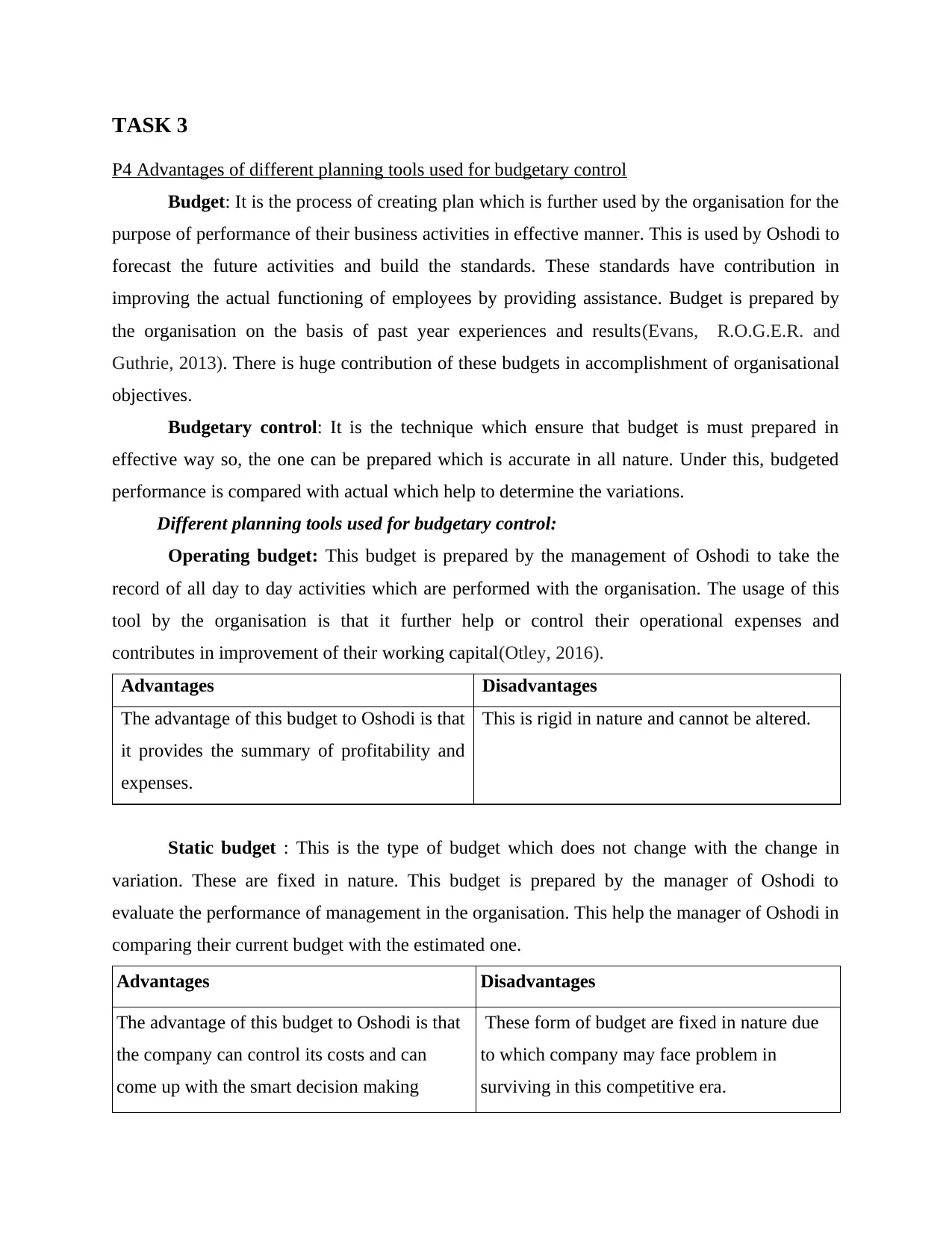
TASK 3
P4 Advantages of different planning tools used for budgetary control
Budget: It is the process of creating plan which is further used by the organisation for the
purpose of performance of their business activities in effective manner. This is used by Oshodi to
forecast the future activities and build the standards. These standards have contribution in
improving the actual functioning of employees by providing assistance. Budget is prepared by
the organisation on the basis of past year experiences and results(Evans, R.O.G.E.R. and
Guthrie, 2013). There is huge contribution of these budgets in accomplishment of organisational
objectives.
Budgetary control: It is the technique which ensure that budget is must prepared in
effective way so, the one can be prepared which is accurate in all nature. Under this, budgeted
performance is compared with actual which help to determine the variations.
Different planning tools used for budgetary control:
Operating budget: This budget is prepared by the management of Oshodi to take the
record of all day to day activities which are performed with the organisation. The usage of this
tool by the organisation is that it further help or control their operational expenses and
contributes in improvement of their working capital(Otley, 2016).
Advantages Disadvantages
The advantage of this budget to Oshodi is that
it provides the summary of profitability and
expenses.
This is rigid in nature and cannot be altered.
Static budget : This is the type of budget which does not change with the change in
variation. These are fixed in nature. This budget is prepared by the manager of Oshodi to
evaluate the performance of management in the organisation. This help the manager of Oshodi in
comparing their current budget with the estimated one.
Advantages Disadvantages
The advantage of this budget to Oshodi is that
the company can control its costs and can
come up with the smart decision making
These form of budget are fixed in nature due
to which company may face problem in
surviving in this competitive era.
P4 Advantages of different planning tools used for budgetary control
Budget: It is the process of creating plan which is further used by the organisation for the
purpose of performance of their business activities in effective manner. This is used by Oshodi to
forecast the future activities and build the standards. These standards have contribution in
improving the actual functioning of employees by providing assistance. Budget is prepared by
the organisation on the basis of past year experiences and results(Evans, R.O.G.E.R. and
Guthrie, 2013). There is huge contribution of these budgets in accomplishment of organisational
objectives.
Budgetary control: It is the technique which ensure that budget is must prepared in
effective way so, the one can be prepared which is accurate in all nature. Under this, budgeted
performance is compared with actual which help to determine the variations.
Different planning tools used for budgetary control:
Operating budget: This budget is prepared by the management of Oshodi to take the
record of all day to day activities which are performed with the organisation. The usage of this
tool by the organisation is that it further help or control their operational expenses and
contributes in improvement of their working capital(Otley, 2016).
Advantages Disadvantages
The advantage of this budget to Oshodi is that
it provides the summary of profitability and
expenses.
This is rigid in nature and cannot be altered.
Static budget : This is the type of budget which does not change with the change in
variation. These are fixed in nature. This budget is prepared by the manager of Oshodi to
evaluate the performance of management in the organisation. This help the manager of Oshodi in
comparing their current budget with the estimated one.
Advantages Disadvantages
The advantage of this budget to Oshodi is that
the company can control its costs and can
come up with the smart decision making
These form of budget are fixed in nature due
to which company may face problem in
surviving in this competitive era.
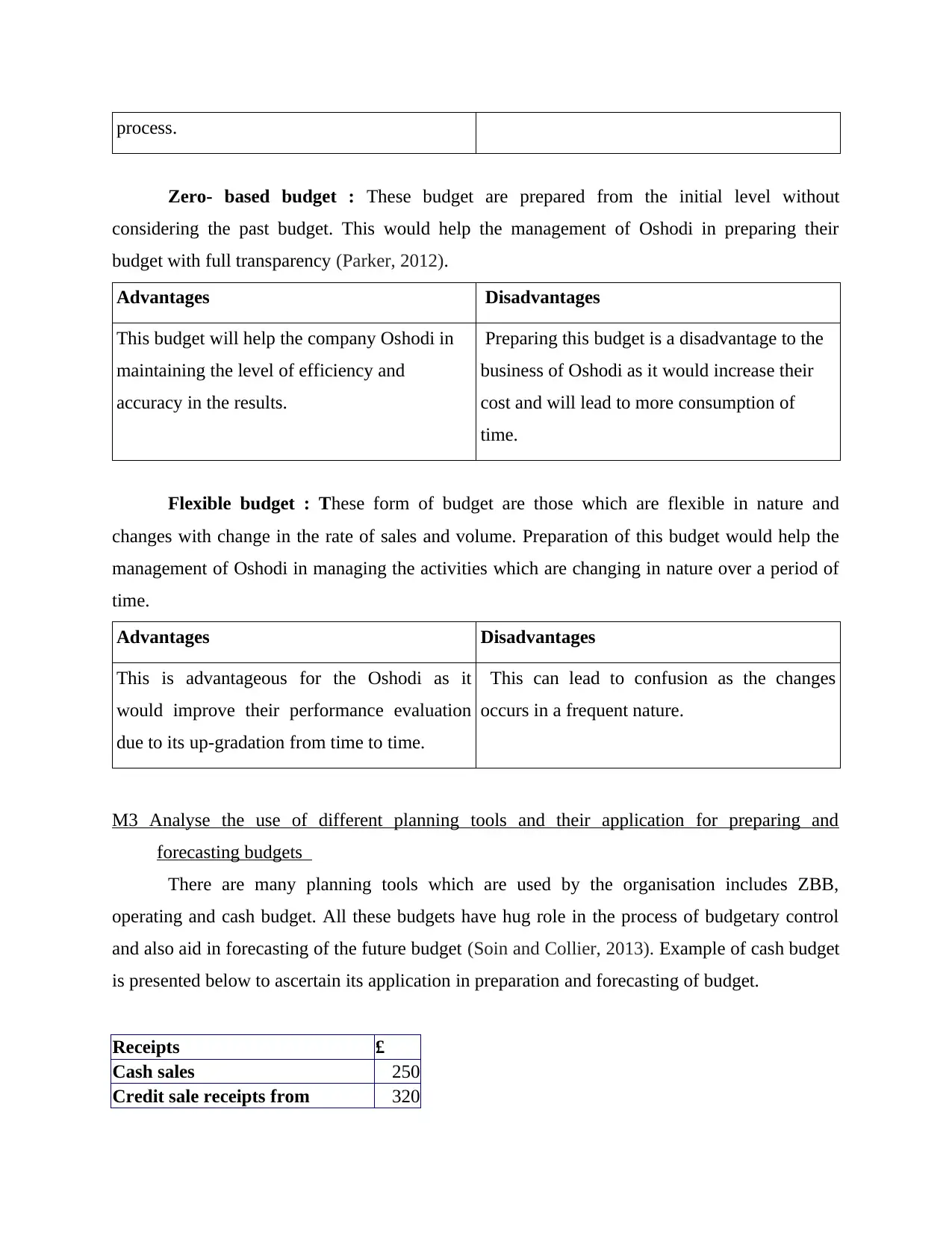
process.
Zero- based budget : These budget are prepared from the initial level without
considering the past budget. This would help the management of Oshodi in preparing their
budget with full transparency (Parker, 2012).
Advantages Disadvantages
This budget will help the company Oshodi in
maintaining the level of efficiency and
accuracy in the results.
Preparing this budget is a disadvantage to the
business of Oshodi as it would increase their
cost and will lead to more consumption of
time.
Flexible budget : These form of budget are those which are flexible in nature and
changes with change in the rate of sales and volume. Preparation of this budget would help the
management of Oshodi in managing the activities which are changing in nature over a period of
time.
Advantages Disadvantages
This is advantageous for the Oshodi as it
would improve their performance evaluation
due to its up-gradation from time to time.
This can lead to confusion as the changes
occurs in a frequent nature.
M3 Analyse the use of different planning tools and their application for preparing and
forecasting budgets
There are many planning tools which are used by the organisation includes ZBB,
operating and cash budget. All these budgets have hug role in the process of budgetary control
and also aid in forecasting of the future budget (Soin and Collier, 2013). Example of cash budget
is presented below to ascertain its application in preparation and forecasting of budget.
Receipts £
Cash sales 250
Credit sale receipts from 320
Zero- based budget : These budget are prepared from the initial level without
considering the past budget. This would help the management of Oshodi in preparing their
budget with full transparency (Parker, 2012).
Advantages Disadvantages
This budget will help the company Oshodi in
maintaining the level of efficiency and
accuracy in the results.
Preparing this budget is a disadvantage to the
business of Oshodi as it would increase their
cost and will lead to more consumption of
time.
Flexible budget : These form of budget are those which are flexible in nature and
changes with change in the rate of sales and volume. Preparation of this budget would help the
management of Oshodi in managing the activities which are changing in nature over a period of
time.
Advantages Disadvantages
This is advantageous for the Oshodi as it
would improve their performance evaluation
due to its up-gradation from time to time.
This can lead to confusion as the changes
occurs in a frequent nature.
M3 Analyse the use of different planning tools and their application for preparing and
forecasting budgets
There are many planning tools which are used by the organisation includes ZBB,
operating and cash budget. All these budgets have hug role in the process of budgetary control
and also aid in forecasting of the future budget (Soin and Collier, 2013). Example of cash budget
is presented below to ascertain its application in preparation and forecasting of budget.
Receipts £
Cash sales 250
Credit sale receipts from 320
⊘ This is a preview!⊘
Do you want full access?
Subscribe today to unlock all pages.

Trusted by 1+ million students worldwide
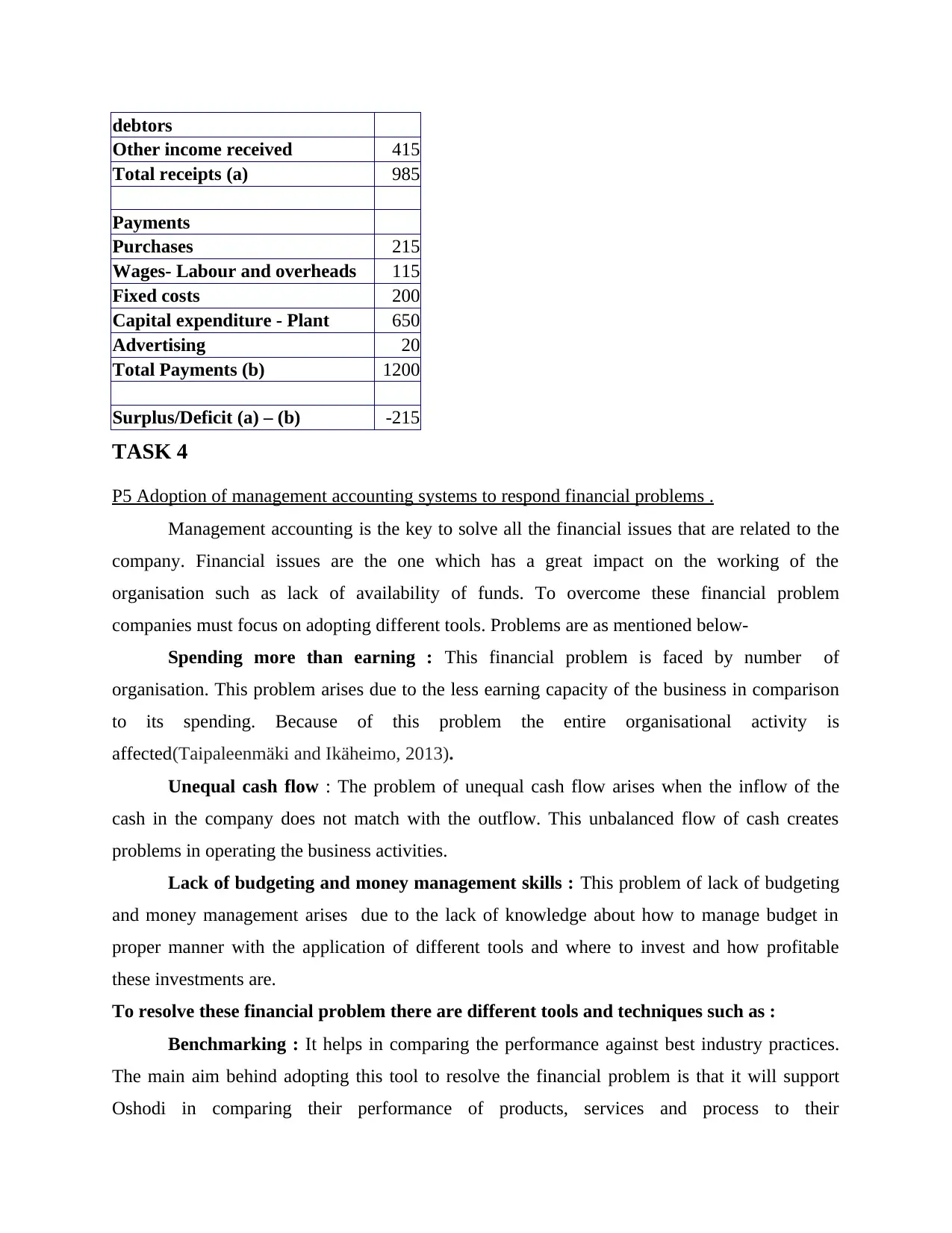
debtors
Other income received 415
Total receipts (a) 985
Payments
Purchases 215
Wages- Labour and overheads 115
Fixed costs 200
Capital expenditure - Plant 650
Advertising 20
Total Payments (b) 1200
Surplus/Deficit (a) – (b) -215
TASK 4
P5 Adoption of management accounting systems to respond financial problems .
Management accounting is the key to solve all the financial issues that are related to the
company. Financial issues are the one which has a great impact on the working of the
organisation such as lack of availability of funds. To overcome these financial problem
companies must focus on adopting different tools. Problems are as mentioned below-
Spending more than earning : This financial problem is faced by number of
organisation. This problem arises due to the less earning capacity of the business in comparison
to its spending. Because of this problem the entire organisational activity is
affected(Taipaleenmäki and Ikäheimo, 2013).
Unequal cash flow : The problem of unequal cash flow arises when the inflow of the
cash in the company does not match with the outflow. This unbalanced flow of cash creates
problems in operating the business activities.
Lack of budgeting and money management skills : This problem of lack of budgeting
and money management arises due to the lack of knowledge about how to manage budget in
proper manner with the application of different tools and where to invest and how profitable
these investments are.
To resolve these financial problem there are different tools and techniques such as :
Benchmarking : It helps in comparing the performance against best industry practices.
The main aim behind adopting this tool to resolve the financial problem is that it will support
Oshodi in comparing their performance of products, services and process to their
Other income received 415
Total receipts (a) 985
Payments
Purchases 215
Wages- Labour and overheads 115
Fixed costs 200
Capital expenditure - Plant 650
Advertising 20
Total Payments (b) 1200
Surplus/Deficit (a) – (b) -215
TASK 4
P5 Adoption of management accounting systems to respond financial problems .
Management accounting is the key to solve all the financial issues that are related to the
company. Financial issues are the one which has a great impact on the working of the
organisation such as lack of availability of funds. To overcome these financial problem
companies must focus on adopting different tools. Problems are as mentioned below-
Spending more than earning : This financial problem is faced by number of
organisation. This problem arises due to the less earning capacity of the business in comparison
to its spending. Because of this problem the entire organisational activity is
affected(Taipaleenmäki and Ikäheimo, 2013).
Unequal cash flow : The problem of unequal cash flow arises when the inflow of the
cash in the company does not match with the outflow. This unbalanced flow of cash creates
problems in operating the business activities.
Lack of budgeting and money management skills : This problem of lack of budgeting
and money management arises due to the lack of knowledge about how to manage budget in
proper manner with the application of different tools and where to invest and how profitable
these investments are.
To resolve these financial problem there are different tools and techniques such as :
Benchmarking : It helps in comparing the performance against best industry practices.
The main aim behind adopting this tool to resolve the financial problem is that it will support
Oshodi in comparing their performance of products, services and process to their
Paraphrase This Document
Need a fresh take? Get an instant paraphrase of this document with our AI Paraphraser
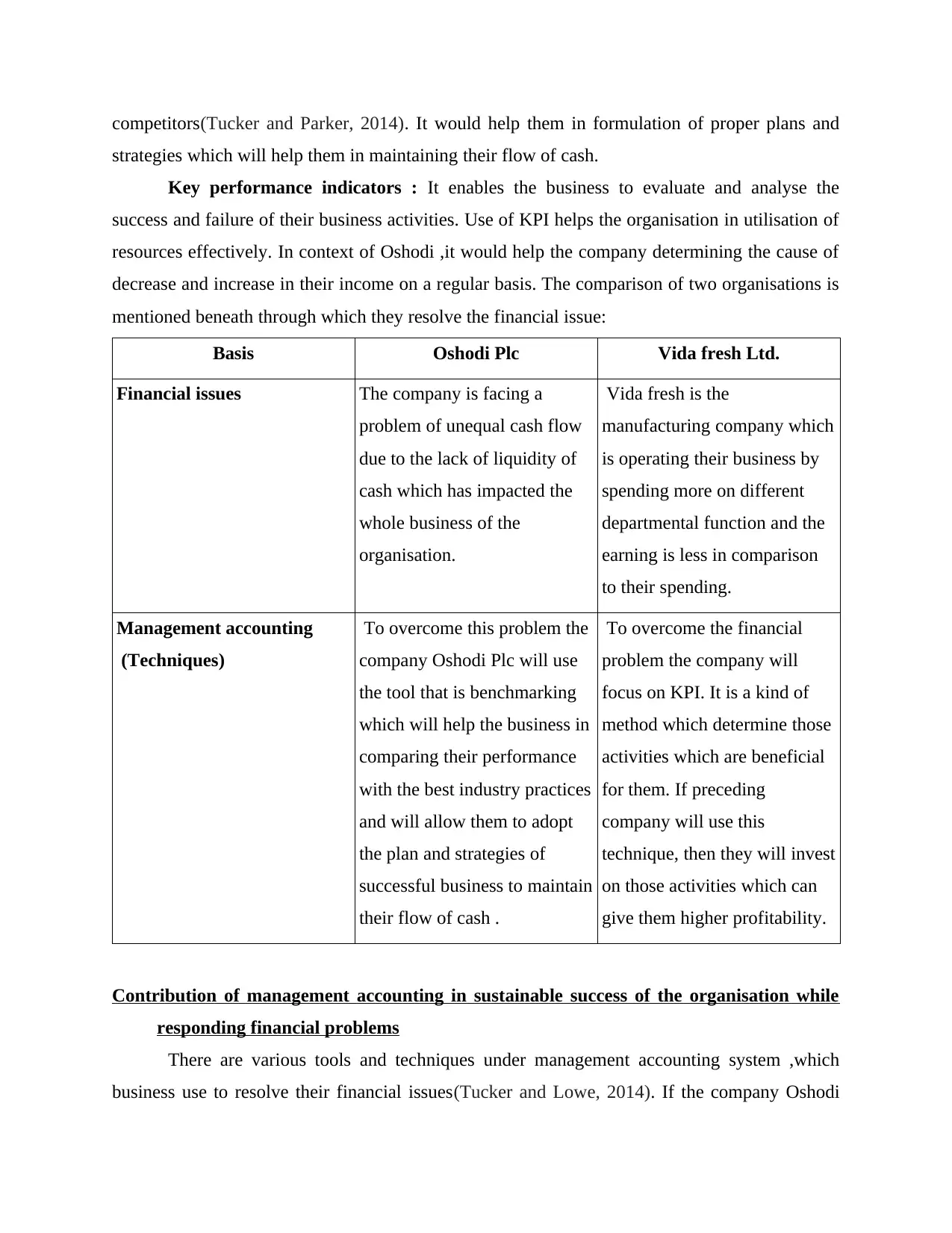
competitors(Tucker and Parker, 2014). It would help them in formulation of proper plans and
strategies which will help them in maintaining their flow of cash.
Key performance indicators : It enables the business to evaluate and analyse the
success and failure of their business activities. Use of KPI helps the organisation in utilisation of
resources effectively. In context of Oshodi ,it would help the company determining the cause of
decrease and increase in their income on a regular basis. The comparison of two organisations is
mentioned beneath through which they resolve the financial issue:
Basis Oshodi Plc Vida fresh Ltd.
Financial issues The company is facing a
problem of unequal cash flow
due to the lack of liquidity of
cash which has impacted the
whole business of the
organisation.
Vida fresh is the
manufacturing company which
is operating their business by
spending more on different
departmental function and the
earning is less in comparison
to their spending.
Management accounting
(Techniques)
To overcome this problem the
company Oshodi Plc will use
the tool that is benchmarking
which will help the business in
comparing their performance
with the best industry practices
and will allow them to adopt
the plan and strategies of
successful business to maintain
their flow of cash .
To overcome the financial
problem the company will
focus on KPI. It is a kind of
method which determine those
activities which are beneficial
for them. If preceding
company will use this
technique, then they will invest
on those activities which can
give them higher profitability.
Contribution of management accounting in sustainable success of the organisation while
responding financial problems
There are various tools and techniques under management accounting system ,which
business use to resolve their financial issues(Tucker and Lowe, 2014). If the company Oshodi
strategies which will help them in maintaining their flow of cash.
Key performance indicators : It enables the business to evaluate and analyse the
success and failure of their business activities. Use of KPI helps the organisation in utilisation of
resources effectively. In context of Oshodi ,it would help the company determining the cause of
decrease and increase in their income on a regular basis. The comparison of two organisations is
mentioned beneath through which they resolve the financial issue:
Basis Oshodi Plc Vida fresh Ltd.
Financial issues The company is facing a
problem of unequal cash flow
due to the lack of liquidity of
cash which has impacted the
whole business of the
organisation.
Vida fresh is the
manufacturing company which
is operating their business by
spending more on different
departmental function and the
earning is less in comparison
to their spending.
Management accounting
(Techniques)
To overcome this problem the
company Oshodi Plc will use
the tool that is benchmarking
which will help the business in
comparing their performance
with the best industry practices
and will allow them to adopt
the plan and strategies of
successful business to maintain
their flow of cash .
To overcome the financial
problem the company will
focus on KPI. It is a kind of
method which determine those
activities which are beneficial
for them. If preceding
company will use this
technique, then they will invest
on those activities which can
give them higher profitability.
Contribution of management accounting in sustainable success of the organisation while
responding financial problems
There are various tools and techniques under management accounting system ,which
business use to resolve their financial issues(Tucker and Lowe, 2014). If the company Oshodi
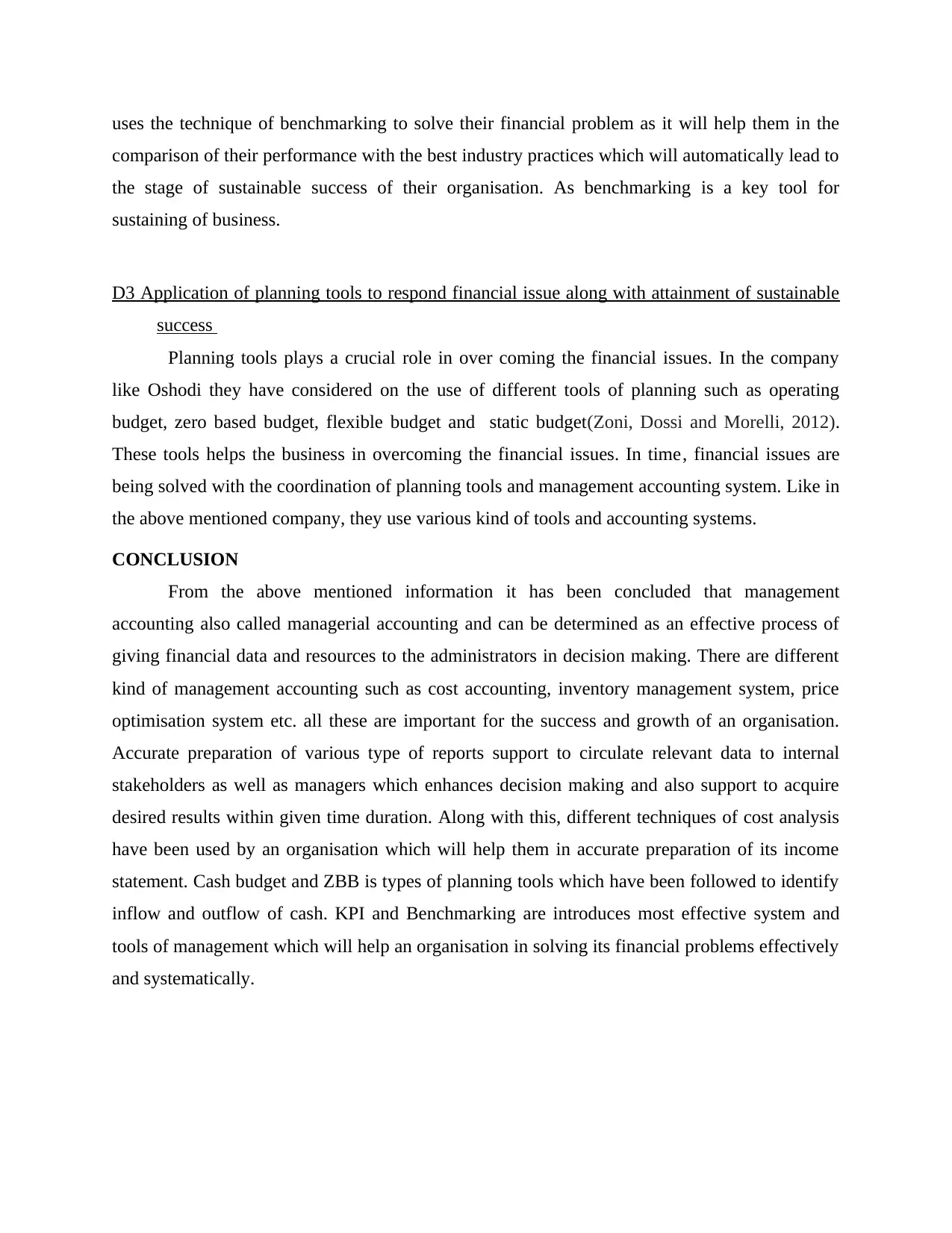
uses the technique of benchmarking to solve their financial problem as it will help them in the
comparison of their performance with the best industry practices which will automatically lead to
the stage of sustainable success of their organisation. As benchmarking is a key tool for
sustaining of business.
D3 Application of planning tools to respond financial issue along with attainment of sustainable
success
Planning tools plays a crucial role in over coming the financial issues. In the company
like Oshodi they have considered on the use of different tools of planning such as operating
budget, zero based budget, flexible budget and static budget(Zoni, Dossi and Morelli, 2012).
These tools helps the business in overcoming the financial issues. In time, financial issues are
being solved with the coordination of planning tools and management accounting system. Like in
the above mentioned company, they use various kind of tools and accounting systems.
CONCLUSION
From the above mentioned information it has been concluded that management
accounting also called managerial accounting and can be determined as an effective process of
giving financial data and resources to the administrators in decision making. There are different
kind of management accounting such as cost accounting, inventory management system, price
optimisation system etc. all these are important for the success and growth of an organisation.
Accurate preparation of various type of reports support to circulate relevant data to internal
stakeholders as well as managers which enhances decision making and also support to acquire
desired results within given time duration. Along with this, different techniques of cost analysis
have been used by an organisation which will help them in accurate preparation of its income
statement. Cash budget and ZBB is types of planning tools which have been followed to identify
inflow and outflow of cash. KPI and Benchmarking are introduces most effective system and
tools of management which will help an organisation in solving its financial problems effectively
and systematically.
comparison of their performance with the best industry practices which will automatically lead to
the stage of sustainable success of their organisation. As benchmarking is a key tool for
sustaining of business.
D3 Application of planning tools to respond financial issue along with attainment of sustainable
success
Planning tools plays a crucial role in over coming the financial issues. In the company
like Oshodi they have considered on the use of different tools of planning such as operating
budget, zero based budget, flexible budget and static budget(Zoni, Dossi and Morelli, 2012).
These tools helps the business in overcoming the financial issues. In time, financial issues are
being solved with the coordination of planning tools and management accounting system. Like in
the above mentioned company, they use various kind of tools and accounting systems.
CONCLUSION
From the above mentioned information it has been concluded that management
accounting also called managerial accounting and can be determined as an effective process of
giving financial data and resources to the administrators in decision making. There are different
kind of management accounting such as cost accounting, inventory management system, price
optimisation system etc. all these are important for the success and growth of an organisation.
Accurate preparation of various type of reports support to circulate relevant data to internal
stakeholders as well as managers which enhances decision making and also support to acquire
desired results within given time duration. Along with this, different techniques of cost analysis
have been used by an organisation which will help them in accurate preparation of its income
statement. Cash budget and ZBB is types of planning tools which have been followed to identify
inflow and outflow of cash. KPI and Benchmarking are introduces most effective system and
tools of management which will help an organisation in solving its financial problems effectively
and systematically.
⊘ This is a preview!⊘
Do you want full access?
Subscribe today to unlock all pages.

Trusted by 1+ million students worldwide
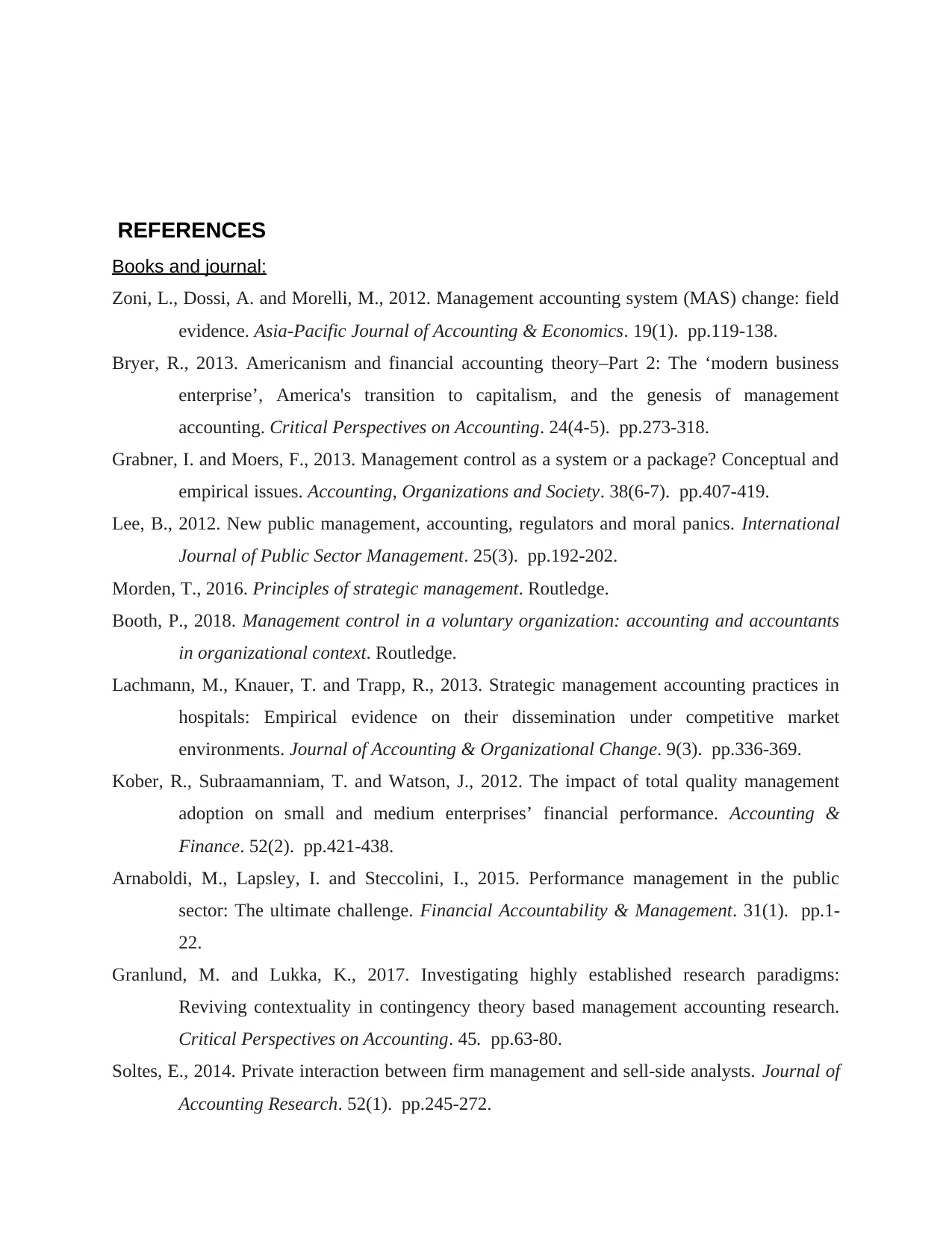
REFERENCES
Books and journal:
Zoni, L., Dossi, A. and Morelli, M., 2012. Management accounting system (MAS) change: field
evidence. Asia-Pacific Journal of Accounting & Economics. 19(1). pp.119-138.
Bryer, R., 2013. Americanism and financial accounting theory–Part 2: The ‘modern business
enterprise’, America's transition to capitalism, and the genesis of management
accounting. Critical Perspectives on Accounting. 24(4-5). pp.273-318.
Grabner, I. and Moers, F., 2013. Management control as a system or a package? Conceptual and
empirical issues. Accounting, Organizations and Society. 38(6-7). pp.407-419.
Lee, B., 2012. New public management, accounting, regulators and moral panics. International
Journal of Public Sector Management. 25(3). pp.192-202.
Morden, T., 2016. Principles of strategic management. Routledge.
Booth, P., 2018. Management control in a voluntary organization: accounting and accountants
in organizational context. Routledge.
Lachmann, M., Knauer, T. and Trapp, R., 2013. Strategic management accounting practices in
hospitals: Empirical evidence on their dissemination under competitive market
environments. Journal of Accounting & Organizational Change. 9(3). pp.336-369.
Kober, R., Subraamanniam, T. and Watson, J., 2012. The impact of total quality management
adoption on small and medium enterprises’ financial performance. Accounting &
Finance. 52(2). pp.421-438.
Arnaboldi, M., Lapsley, I. and Steccolini, I., 2015. Performance management in the public
sector: The ultimate challenge. Financial Accountability & Management. 31(1). pp.1-
22.
Granlund, M. and Lukka, K., 2017. Investigating highly established research paradigms:
Reviving contextuality in contingency theory based management accounting research.
Critical Perspectives on Accounting. 45. pp.63-80.
Soltes, E., 2014. Private interaction between firm management and sell‐side analysts. Journal of
Accounting Research. 52(1). pp.245-272.
Books and journal:
Zoni, L., Dossi, A. and Morelli, M., 2012. Management accounting system (MAS) change: field
evidence. Asia-Pacific Journal of Accounting & Economics. 19(1). pp.119-138.
Bryer, R., 2013. Americanism and financial accounting theory–Part 2: The ‘modern business
enterprise’, America's transition to capitalism, and the genesis of management
accounting. Critical Perspectives on Accounting. 24(4-5). pp.273-318.
Grabner, I. and Moers, F., 2013. Management control as a system or a package? Conceptual and
empirical issues. Accounting, Organizations and Society. 38(6-7). pp.407-419.
Lee, B., 2012. New public management, accounting, regulators and moral panics. International
Journal of Public Sector Management. 25(3). pp.192-202.
Morden, T., 2016. Principles of strategic management. Routledge.
Booth, P., 2018. Management control in a voluntary organization: accounting and accountants
in organizational context. Routledge.
Lachmann, M., Knauer, T. and Trapp, R., 2013. Strategic management accounting practices in
hospitals: Empirical evidence on their dissemination under competitive market
environments. Journal of Accounting & Organizational Change. 9(3). pp.336-369.
Kober, R., Subraamanniam, T. and Watson, J., 2012. The impact of total quality management
adoption on small and medium enterprises’ financial performance. Accounting &
Finance. 52(2). pp.421-438.
Arnaboldi, M., Lapsley, I. and Steccolini, I., 2015. Performance management in the public
sector: The ultimate challenge. Financial Accountability & Management. 31(1). pp.1-
22.
Granlund, M. and Lukka, K., 2017. Investigating highly established research paradigms:
Reviving contextuality in contingency theory based management accounting research.
Critical Perspectives on Accounting. 45. pp.63-80.
Soltes, E., 2014. Private interaction between firm management and sell‐side analysts. Journal of
Accounting Research. 52(1). pp.245-272.
Paraphrase This Document
Need a fresh take? Get an instant paraphrase of this document with our AI Paraphraser
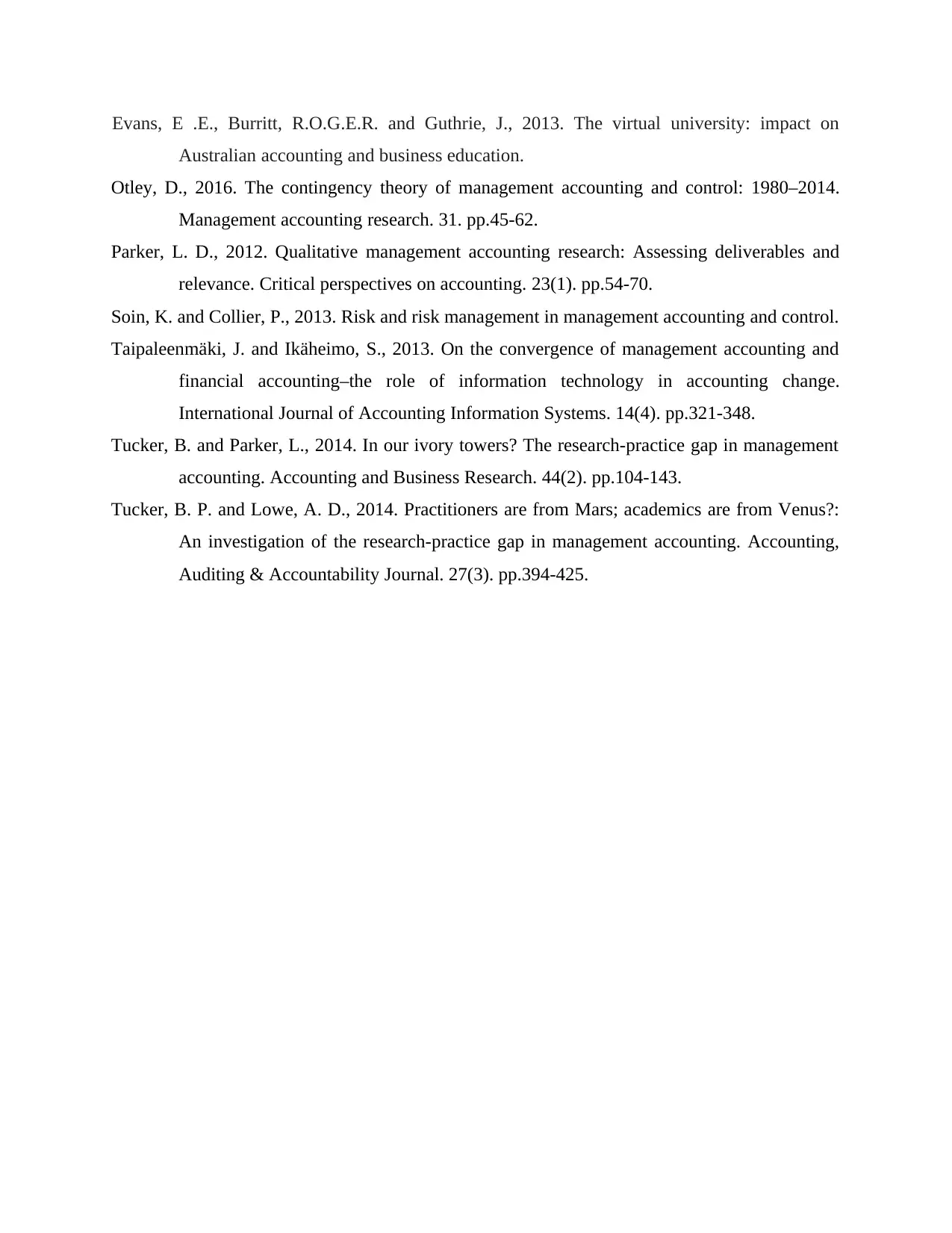
Evans, E .E., Burritt, R.O.G.E.R. and Guthrie, J., 2013. The virtual university: impact on
Australian accounting and business education.
Otley, D., 2016. The contingency theory of management accounting and control: 1980–2014.
Management accounting research. 31. pp.45-62.
Parker, L. D., 2012. Qualitative management accounting research: Assessing deliverables and
relevance. Critical perspectives on accounting. 23(1). pp.54-70.
Soin, K. and Collier, P., 2013. Risk and risk management in management accounting and control.
Taipaleenmäki, J. and Ikäheimo, S., 2013. On the convergence of management accounting and
financial accounting–the role of information technology in accounting change.
International Journal of Accounting Information Systems. 14(4). pp.321-348.
Tucker, B. and Parker, L., 2014. In our ivory towers? The research-practice gap in management
accounting. Accounting and Business Research. 44(2). pp.104-143.
Tucker, B. P. and Lowe, A. D., 2014. Practitioners are from Mars; academics are from Venus?:
An investigation of the research-practice gap in management accounting. Accounting,
Auditing & Accountability Journal. 27(3). pp.394-425.
Australian accounting and business education.
Otley, D., 2016. The contingency theory of management accounting and control: 1980–2014.
Management accounting research. 31. pp.45-62.
Parker, L. D., 2012. Qualitative management accounting research: Assessing deliverables and
relevance. Critical perspectives on accounting. 23(1). pp.54-70.
Soin, K. and Collier, P., 2013. Risk and risk management in management accounting and control.
Taipaleenmäki, J. and Ikäheimo, S., 2013. On the convergence of management accounting and
financial accounting–the role of information technology in accounting change.
International Journal of Accounting Information Systems. 14(4). pp.321-348.
Tucker, B. and Parker, L., 2014. In our ivory towers? The research-practice gap in management
accounting. Accounting and Business Research. 44(2). pp.104-143.
Tucker, B. P. and Lowe, A. D., 2014. Practitioners are from Mars; academics are from Venus?:
An investigation of the research-practice gap in management accounting. Accounting,
Auditing & Accountability Journal. 27(3). pp.394-425.
1 out of 17